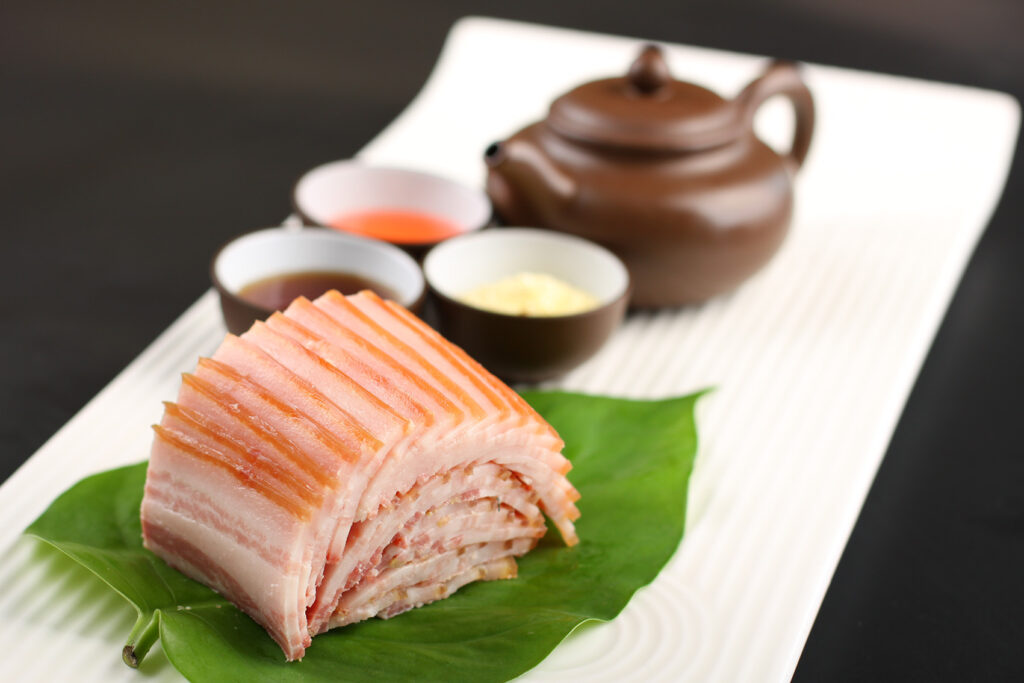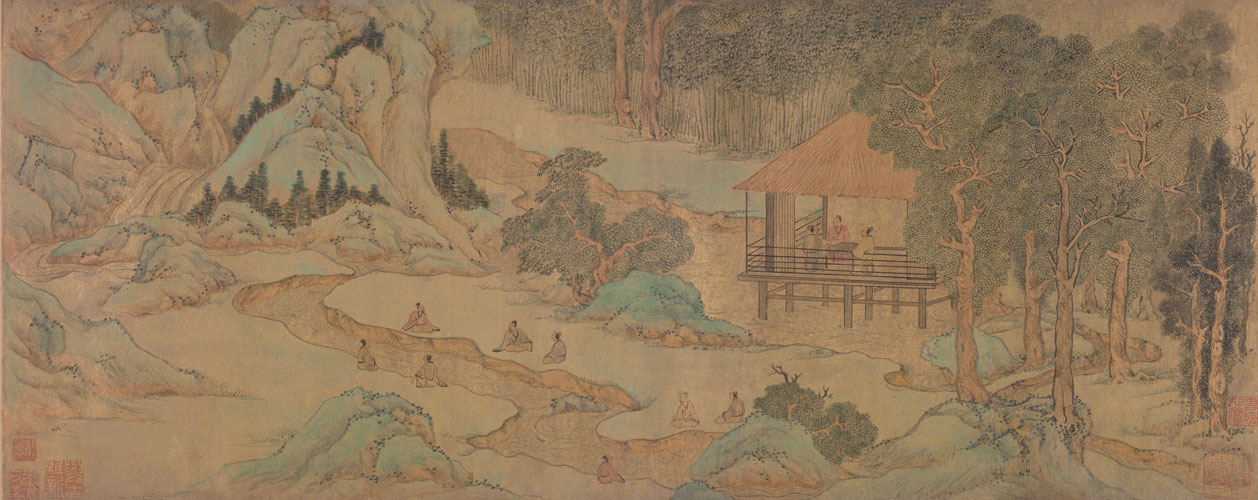
今年11月7日,即农历九月廿二,是一年中的第十九个节气——立冬,标志着冬季的开始。这是水始冰、地始冻、万物收藏的季节,也是秋收冬种的时节。
November 7, or the 22nd of the ninth month of Chinese lunar calendar, is the nineteenth solar term – Lidong (Beginning of Winter). As the name suggests, it marks a time when water starts to freeze and all beings prepare for winterization, while It is also when autumn harvest is finished and winter crops are planted.
– 补冬 / Winter Nourishment
冬季伊始,民间讲究进补以度寒冬。在北方要吃饺子,还有自清代宫廷延续而来的涮羊肉。南方则更多食用鸡鸭鱼肉等热量较高的食物,配合中药炖煮,增加滋阴补阳的功效。
Winter nourishment is essential at the beginning of winter. In North China, people eat dumplings and mutton hot pot, a tradition passed down from the imperial court of the Qing dynasty. In South China, people are more inclined to have all kinds of meat stewed with traditional Chinese herbs and other high-calorie food.

涮羊肉 Beijing Mutton Hot Pot

定海 鮸鱼十吃 Croaker Cooked in Ten Ways, Dinghai, Zhejiang

江山白鹅 Jiangshan stewed goose

开化腊肉 Kaihua cured meat
– 酿黄酒 / Brew yellow rice wine
自古以来,立冬之后中国民间普遍有酿冬酒的传统,以绍兴黄酒最为著名。立冬是绍兴黄酒开始投料发酵的日子。冬季水体清冽、气温低,可有效抑制杂菌繁育,确保发酵顺利进行,又能使酒在低温长时间发酵过程中形成良好的风味,是酿酒发酵最适合的季节。因此绍兴人把从立冬开始到第二年立春这段最适合做黄酒的时间称为“冬酿”。
It is a popular and time-honored tradition that people brew winter liquors after Lidong, among which Shaoxing Yellow Rice Wine is the most famous. Lidong is the time when fermentation of Shaoxing wine begins. Clear water and low temperature in winter can effectively prevent bacteria contamination to ensure successful fermentation and a satisfactory flavor in the process of long-term low-temperature fermentation. Therefore, Shaoxing people engage in “winter brewing” from Lidong (Beginning of Winter) to Lichun (Beginning of Spring) in the next year, the most suitable time for making yellow rice wine.

绍兴黄酒 Shaoxing wine
黄酒是世界上最古老的饮料酒之一,与啤酒、葡萄酒并称世界三大古酒。黄酒源于中国,根据产地、原料、曲种、含糖量等可分为众多品种,其中又以绍兴酒最具代表性。
Yellow rice wine is one of the oldest types of beverage wine in the world, known as the Three Ancient Alcoholic Drinks together with beer and grape wine. Originated in China, yellow rice wine can be divided into many varieties according to the origin, raw materials, types of distiller’s yeast and sugar content etc., among which Shaoxing wine is the most typical brand.

绍兴黄酒小镇 Shaoxing Rice Wine Town
绍兴酿酒的历史非常悠久,文字记载可追溯至春秋战国时期,是越地先民传承和发展下来的绝技,于2006年被列入国家级非物质文化遗产名录。这里土地肥沃,气候温和,日照充足,四季分明,又有鉴湖这一丰沛而优质的水源,酿酒可谓得天独厚。
Shaoxing enjoys a long history of wine making. It is a technique inherited and developed by ancestors in the State of Yue with written records dating back to the Spring and Autumn period and Warring States period. In 2006, Shaoxing wine making technique was listed as a national intangible cultural heritage. Fertile land, mild climate, abundant sunshine and rich and high-quality water source of Jianhu Lake make Shaoxing a favorable place to brew wine.

酒坛 Wine jar
千百年来,酒浸润着诗情,诗赋予酒灵魂。永和九年的绍兴兰亭,文人雅士引曲水流觞饮酒咏诗的胜景被永远记录在《兰亭集》和书圣王羲之所作《兰亭集序》中。他们列坐溪边,将盛满酒的羽觞放入水中任其顺流而下,杯停在谁的面前,谁便取饮赋诗。如今《兰亭集序》真迹所在尚不明确,不过以唐代书法家冯承素的摹本流传最广,此次雅集也成为众多艺术创作的主题。
For thousands of years, wine is infused with poetic sentiment and poetry breathes vitality into wine. At the Orchid Pavilion (Lanting) in Shaoxing in the ninth year under the reign of Emperor Mu of Eastern Jin dynasty (A.D. 353), one of the most celebrated literati gatherings took place and was recorded in the Preface to the Poems Composed at the Orchid Pavilion written by the most eminent Chinese calligrapher Wang Xizhi. They engaged in “Qu Shui Liu Shang”, an ancient game derived from the customs of Double Third Festival since Zhou dynasty. They sat by a winding stream, put cups full of wine in the water and let them flow. Whoever had the cup stopped in front of him would drink it and create a poem. The original calligraphy work of the Preface is yet to be found, however, the copy by a calligrapher of the Tang dynasty Feng Chengsu is the most acknowledged version. The gathering has thereafter become the theme of many artistic creations.

《冯摹兰亭序》卷 唐 冯承素摹 纸本 行书 纵24.5厘米 横69.9厘米 现藏于故宫博物院
Preface to the Poems Composed at the Orchid Pavilion, Tang dynasty, Feng Chengsu
Semi-cursive script on paper, 24.5 cm x 69.9 cm
Now in the collection of the Palace Museum

《曲水流觞图》卷 明 黄宸绘 纸本 墨笔 纵29.8厘米 横252.4厘米 现藏于故宫博物院
Qu Shui Liu Shang, Ming dynasty, Huang Chen
Ink on paper, 29.8 cm x 252.4 cm
Now in the collection of the Palace Museum

《兰亭修褉图》卷 明嘉靖二十一年(1542年) 文徵明绘 金笺地 设色 纵24.2厘米 横60.1厘米 现藏于故宫博物院
Xiuxi Ritual at the Orchid Pavilion, Ming dynasty (1542), Wen Zhengming
Ink and color on gold-dusted paper, 24.2 cm x 60.1 cm
Now in the collection of the Palace Museum
曲水流觞的习俗流传至今。在兰亭,饮一杯黄酒,诵一首诗文,畅叙怀古幽情。
The tradition of Qu Shui Liu Shang remains even today. The Orchid Pavilion is a historical landmark where you can drink a cup of yellow rice wine, recite a poem and exchange reflections of the past.

兰亭雅集·曲水流觞 Qu Shui Liu Shang at the Orchid Pavilion
资料来源 / Sources:
http://www.ihchina.cn
http://www.shaoxingwine.com.cn
浙江省文化和旅游厅
绍兴市文化广电旅游局
北京市文化和旅游局
https://www.facebook.com/China-Cultural-Center-in-Stockholm-110983273921638
Instagram: chinaculturalcenterinstockholm
https://www.instagram.com/chinaculturalcenterinstockholm/
Tik Tok: cccinstockholm
@cccinstockholm
Wechat: 斯德哥尔摩中国文化中心 or scan the QR code below

